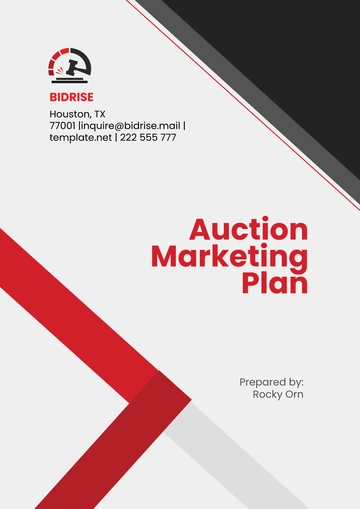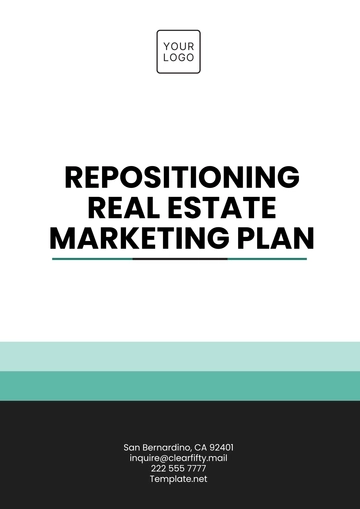Free Pre-Construction Real Estate Marketing Plan Format

1. Title Page
Project Name: Include the name of the development project.
Prepared By: List the individual, agency, or team responsible for the plan.
Date: Provide the date the plan is finalized.
2. Executive Summary
Overview: Briefly summarize the project and its objectives.
Goals: Outline the primary goals of the marketing strategy, such as generating pre-sales, building brand awareness, or attracting investors.
Target Audience: Highlight the key demographic or buyer segments.
Marketing Budget: Provide an estimated budget for executing the plan.
3. Project Overview
Location: Describe the project's location and its unique selling points.
Type of Development: Specify whether it's residential, commercial, or mixed-use.
Key Features: Highlight major amenities, design elements, or sustainability features.
4. Market Analysis
Market Trends: Discuss current trends affecting the real estate market.
Competitive Analysis: Identify competing developments and their marketing strategies.
SWOT Analysis: Present strengths, weaknesses, opportunities, and threats related to the project.
5. Target Audience Analysis
Buyer Profiles: Define target audience demographics (e.g., young professionals, families, retirees).
Preferences and Needs: Detail the specific needs or preferences of the target market.
Behavioral Insights: Include insights such as purchasing motivations and decision-making processes.
6. Branding and Messaging Strategy
Project Branding: Define the brand identity, including logo, color palette, and tone.
Core Messages: Craft messages that resonate with the target audience.
Differentiation: Highlight what sets this project apart from competitors.
7. Marketing Strategies and Channels
Digital Marketing
Website: Develop a project-specific website with detailed information and virtual tours.
Social Media: Create campaigns on platforms like Facebook, Instagram, and LinkedIn.
Email Marketing: Design email newsletters targeting potential buyers and investors.
SEO and SEM: Optimize search engine rankings and run pay-per-click ads.
Traditional Marketing
Billboards and Print Ads: Utilize local media and outdoor advertising.
Brochures and Flyers: Distribute printed materials to attract potential buyers.
Open Houses/Previews: Host exclusive events showcasing project details.
8. Sales Funnel Development
Lead Generation: Outline strategies to capture leads (e.g., online forms, event registrations).
Lead Nurturing: Describe how leads will be engaged through personalized communication.
Conversion Tactics: Detail processes to close deals, such as special offers or financing assistance.
9. Marketing Timeline
Phase | Activity | Timeframe | Responsibility |
|---|---|---|---|
Market Research | Conduct surveys, analyze trends | Month 1 | Marketing Team |
Branding | Finalize brand identity | Month 2 | Design Team |
Pre-Launch Campaign | Digital ads, brochures, website | Month 3 | Marketing and Sales Team |
10. Budget Allocation
Category | Estimated Cost |
|---|---|
Digital Advertising | |
Print Media | |
Event Hosting | |
Website Development | |
Miscellaneous |
11. Performance Metrics and KPIs
Website Traffic: Number of visitors and leads captured.
Social Media Engagement: Likes, shares, comments, and click-through rates.
Pre-Sales: Units sold before construction begins.
Event Attendance: Number of participants in open houses or previews.
12. Risk Management
Potential Risks: Identify risks such as market downturns or budget overruns.
Mitigation Strategies: Outline plans to address potential challenges.
13. Conclusion and Recommendations
Summarize the importance of the plan and recommend steps for ensuring the project achieves its goals.
14. Appendices
Market research data.
Creative assets (logos, sample ads).
Contact list of stakeholders.
- 100% Customizable, free editor
- Access 1 Million+ Templates, photo’s & graphics
- Download or share as a template
- Click and replace photos, graphics, text, backgrounds
- Resize, crop, AI write & more
- Access advanced editor
The Pre-Construction Real Estate Marketing Plan Format Template from Template.net is an editable and customizable tool designed to promote pre-construction properties. Tailor the format to your specific needs with ease using our Ai Editor Tool. This professional template helps you create a strategic marketing plan to effectively attract potential buyers and investors.





























